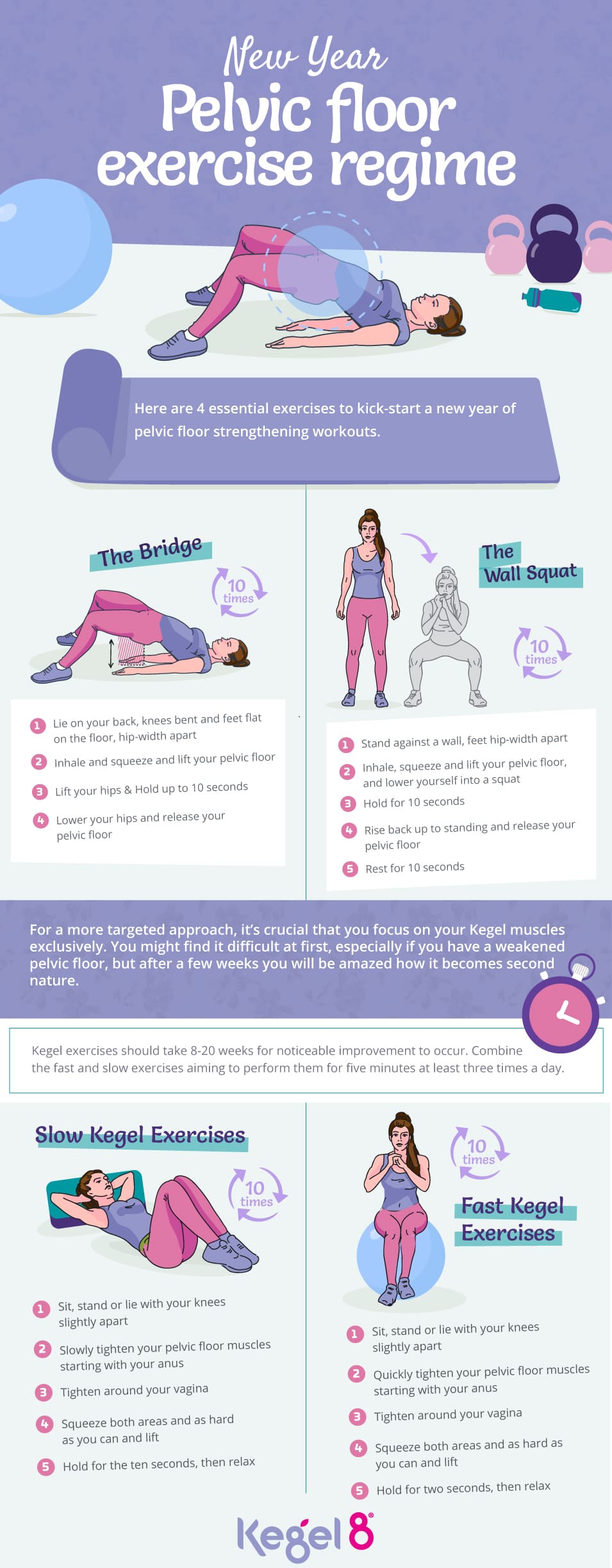
The muscles you need to remember to exercise in 2018.
During Christmas it's very easy to overindulge. In fact, on average, people put on half a stone over the festive period according to British Dietetic Association. While most of us see this as par for the course with all the huge dinners we've put away, this weight gain can have a negative effect on your pelvic floor health. Even a small amount of weight gain can provoke the onset of issues such as stress incontinence caused by a weakened pelvic floor.
Here's the common scenario:
- You're determined to hit the gym more in 2018 and sign up for an induction.
- After browsing the sales you've kitted yourself out with some snazzy new lycra exercise gear and are ready to kickstart your fitness journey.
- The coach leading your session asks you to start out by taking a gentle run on the treadmill.
- You aren't aware that due to a combination of inactivity and Christmas weight gain your pelvic floor has weakened.
- As you're jogging you experience an involuntary leak.
- The embarrassment grinds your healthy New Year plans to a halt
Did you know? Weight gain and pelvic floor health are intrinsically linked - excess pounds cause additional stress.
"By losing 10% of your body weight, you can increase the strength of your pelvic floor by 50%" - Consultant Urogynaecologist Mark Slack
If this happens to you, there's no reason to feel ashamed - yes it can be an embarrassing situation - but 1 in 3 women will suffer from a pelvic floor issue at some point in their life. However, despite being such a common issue, 70%of people with urinary leakage do not seek advice and treatment for their problem. There's no need to hide away if you're properly educated on the subject and there are steps you can take to ensure you're keeping your pelvic floor muscles fighting fit. So, if you're looking to get fit for New Year, it's crucial that while you tackle the machines, weights and spinning sessions you don't neglect to exercise your Kegels to ensure you're fighting fit inside and out. A healthy pelvic floor is also important for strengthening your core muscles to help you achieve your goal of a flat tummy in 2018. It's also essential to watch what you're eating as certain food can have a negative impact on pelvic floor health.
Exercising Your Pelvic Floor
If you're making it your 2018 resolution to get fit, even if you aren't eager to hit the gym, don't forget to pay some attention to your Kegels in the new year. It's always tempting to focus on legs, bums and tums but if you're keen on avoiding common issues like laughter leaks and stress incontinence - don't neglect your pelvic floor muscles. Kegel8 offers products designed to make strengthening simple including a variety of electronic toners and a wide range of accessories to fit all our customers' specific needs.
Exercise Plan
Here are some recommended exercises to incorporate into your next gym (or home) workout to ensure that your pelvic floor is as fit and strong as you feel.


Your New Pelvic Floor Diet


As you can see in the graphic above, studies into pelvic floor health have flagged up the most beneficial and detrimental foods to look out for. Here is some more information about the items listed and how they can help or hinder you in your journey to a happy, healthy pelvic floor.
Must Haves...
If you're looking to improve your pelvic floor health through changes to your diet, the following examples are a great place to start.
- Water - Ensure you're getting plenty of H20 to hydrate your body and flush out toxins. This also helps digestion and all your other bodily functions occur more smoothly.
- Herbal & Caffeine-free Teas - Offering natural nutrition and hydration, herbal alternatives aren't known to cause the problems that caffeine or unnaturally sweetened drinks do.
- Low-Acidic Fruit and Vegetables - Providing the body with important nutrients without causing irritation to the pelvic floor, these fruit and vegetable varieties are the safer option when compared to more acidic alternatives.
- Omega-3 Fatty Acids - Found in several fish species, Omega-3 naturally decreases inflammation, helping to reduce any irritation that may occur from other food or drink.
- High Fibre Foods - Fibre promotes the wave-like contractions that move food through the intestine easing digestion and preventing any undue pressure being placed on your bladder.
- Supplements - A healthy diet and some vital supplements play an important role in the health and functionality of the pelvic floor. Pelvic floor exercise is enhanced with some supplements, helping to strengthen the foundation even more for longer lasting results.
Did you know?
- There's a direct correlation between low Vitamin D3 levels in the body and a weak pelvic floor.
- Oregano Oil capsules lower the risk of candida and yeast infections.
- D-Mannose can remove bacteria from the bladder flushing out 90% of urinary tract infections.
Steer Clear...
While we would never discourage you from treating yourself from time to time, if you can avoid food and drinks listed below, you'll feel the benefits in your pelvic floor.
- Caffeinated Beverages - Acting as diuretics and bladder irritants caffeinated drinks cause your kidneys to make more urine that normal causing overuse and bladder sensitivity.
- Fizzy Drinks - These can cause overactive bladder symptoms due to the carbonation tickling and irritating your bladder. They also contain caffeine and artificial sweeteners, which act as bladder irritation triggers.
- Alcohol - A diuretic and bladder irritant, alcohol accelerates the rate that kidneys gather water and causes the bladder to empty more often. Not a good combination when considering your pelvic health.
- Highly acidic Fruit & Vegetables - When eaten to excess, fruit and veg with a higher acidic content can irritate your bladder lining.
- Spicy Foods - Foods with lots of spice can cause your bladder to burn for the same reason that they cause your mouth to burn, irritating your bladder lining.
- Artificial Sugars and Sweeteners - These synthetic sugar alternatives can worsen symptoms of overactive bladder for similar reasons as carbonated beverages.
- Salt - Avoid overly salty foods as these can overstimulate your bladder leading to more trips to the toilet both through the day and at night, effecting your sleeping pattern as well as your pelvic floor health.



